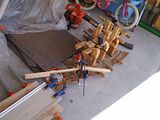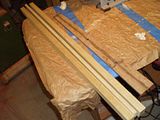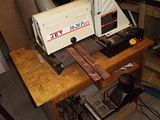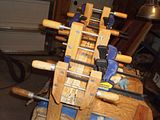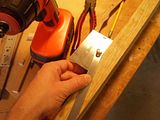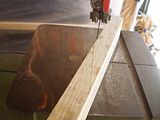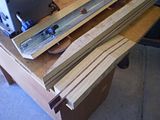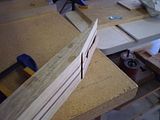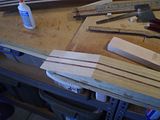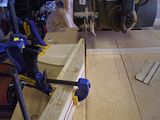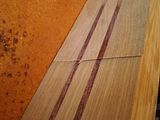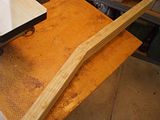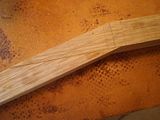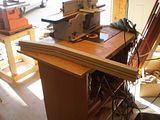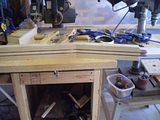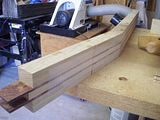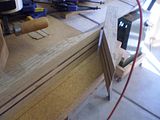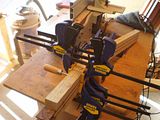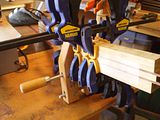Flame Maple/Ebony neck attached to a super thin Undecided body with Hipshot parts and Diablo pickups.
Aiming for another shredder 6 strings light enough to enjoy.
Neck :Flame Maple/Ebony
Fretboard : ????
Scale : 25.5
Frets : 24
Trussrod : ALLPARTS
Body : ???? (33mm)
Tuners : Hipshot
Pickups : Diablo
Bridge : Hipshot
Electronics : 1 Push/pull
Neck blank and the possible top glued together.

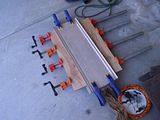
Preparing the neck blank. Square one side on the jointer so I can run it through the drum sander. Of course the jointer loves to tear and chip flamed wood so I use very minimal cuts and stop as soon as it is flat enough. Then I run it through the drum sander. The blank really needs to be square and true. If not the jigs do not work right.
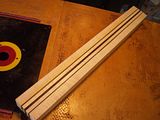

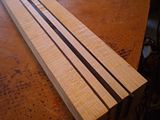

Allright lets cover a standard scarf joint on this build. I like the neck scarf when I need to conserve wood.
Thinking about it lets cover mid neck scarf joints and headstock angle in one conversation. I am still not sure what the perfect headstock angle is. I started out with classic Gibson 14 degree headstock angles. No real reasoning behind them just did it because that is what Gibson does. (I would like to add before I am flamed "Gibson uses a 17 degree headstock". I know it uses 17 degrees on a lot (most now) of its models. My favorite model is a 1971 Medallion Gibson Flying V which to the best of my knowledge a 14 degree headstock and a volute.) When I first started the Ibanez Wizard was the greatest neck I had ever played. Yes I grew up and realized that the thin Gibson with the 1 11/16" nut is the greatest neck ever. My absolute favorite neck is a 93 RG470 Wizard. It is 1 11/16" nut, 17mm at the third fret, and funny enough a 14 degree headstock. So when I was working on the S9 I decided I would fix the little things I did not like on my 93 RG470 neck. I ended up with a 1 3/4" nut (George Lynch Style) and 20mm ( or 21 or 22 depending) profile from the 1st to at least the 15th fret. Later on I started experimenting with shallower angles. I moved to 12 degrees then to 10 degree but honestly on non-tremolo guitars I didn't see enough difference. Carvin uses 8 degrees. PRS uses 10 or 12 degrees. I have just settled on the 14 degree headstock angle.
The idea with headstock angle is break angle downforce verse binding tension. So if you have too much angle you create a bind point at the nut. The downforce of the string and the friction of the nut have to co-exist. You would like the string to be able to move forward and backwards in the nut easily without binding. If you have too much break angle the string will bite into the nut and cause some tuning issues (that little catch were all the sudden the string jumps past in tune to flat). As the break angle becomes more shallow you get less friction against the nut. This is a benefit with a non-locking tremolo and regular bone nut as you are able to return to zero easily (with a little graphite in the slot). However as you lessen the break angle you run the risk of vibration and rattle from the string floating in the slot.
Wood conservation is another issue. It is pretty easy to find 24" x 1 3/4" pieces of exotic woods. But it is not as easy to find 30" or 36" x 1 1/2" pieces of exotic woods. I can build a mid scarf neck out of a 24" L x 1 3/4" D x 2 3/4" W neck blank. When you decrease the angle of the headstock/scarf it lengthens the blank. With a 14 degree headstock angle I am able to get a mid scarf neck out of a relatively small blank.
Why do I still use 14 degrees? I have used 10 - 12 - 14 and I settled on 14 because that is what Gibson used (go ahead and say voodoo) and I build mostly fixed bridges these days. It saves me wood in certain situations and is easy to do with a radial arm saw of a chop saw.
Time to mark the blank. It is a little thinner than I wanted (1.6 vs 1.75) but it will do.

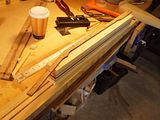
I use the template to mark the start of the neck thickness, 24th fret, the heal, and the cutt-off at the end. The start of the fretboard and the nut position do not actually fit on the blank (they end up in the headstock piece). I get the headstock from the bottom of the blank before the heal. I like the headstock piece to be between 1" - 1.25" thick. This puts the scarf under the 3rd fret were it belongs. When the scarf is in the right place the fretboard helps to reinforce the joint. When the scarf creeps into the headstock/volute area it is just a joint (no reinforcement). Once laid out we go to the Radial arm saw and cut the scarf while the blank is still square.
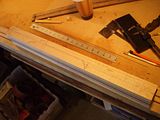
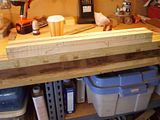
Here is the Scarf Jig. Pretty simple actually. 8/4 piece of poplar cut at 14 degrees off 90 degrees. With a face plate glued to it that gives my a place to clamp. One important part is that it is completely square to the table. The scarf will be crooked if it is not.
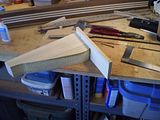
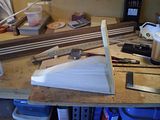
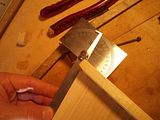
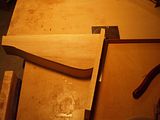
The jig is clamped to the table and the neck blank is clamped to the jig. This keeps the fingers away from the monster and helps protect against kick back. I go very slow and carefully guide the saw through the cut. It has a tendency to grab and pull itself into the blank... bad things. Oh don't loose the little cutt-off as we will use that later when we are clamping.
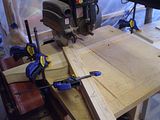
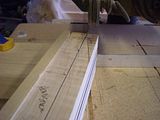

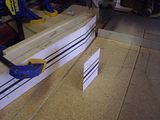
Now to free our headstock from the blank. Setup the bandsaw fence to rip a 1" (actually .95") piece from the back of the blank. I stop at the heal section.
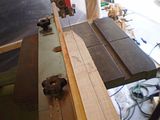
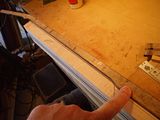
After freeing the headstock section I run it through the drum sander to true it up. Now the reason we made sure everything was square becomes more apparent. Since everything is square lining up the stripes is easy. Lay the blank on a flat surface and check it.
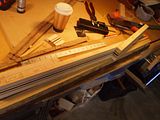
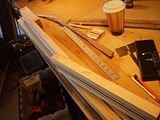
Remember our little cut off? well we will use that to create a flat clamping surface. Once the neck is aligned use a quick clamp to hold the joint and drill some locater/holding pins. These pins should be at the very edges of the blank so they are not in the neck at any point.
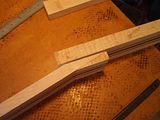
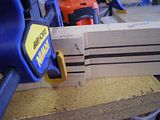
Cover both surfaces with glue and position the neck on the flat surface. Use a quick clamp to hold it temporarily while you locate your pins and drive them in. Break out a bigger clamp and position it right in the front of the fretboard side of the scarf making sure it is centered in the blank. This will put the most pressure in the part of the actual scarf that will survive the neck build. Then reposition your other clamps to fit.
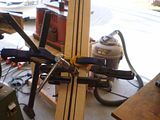
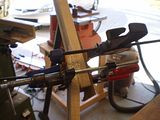
Finished for the day as I am out of clamps.
